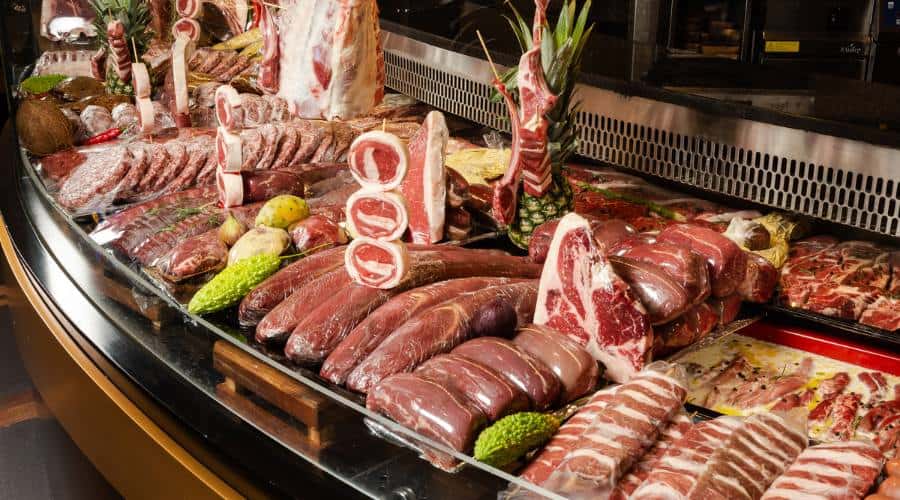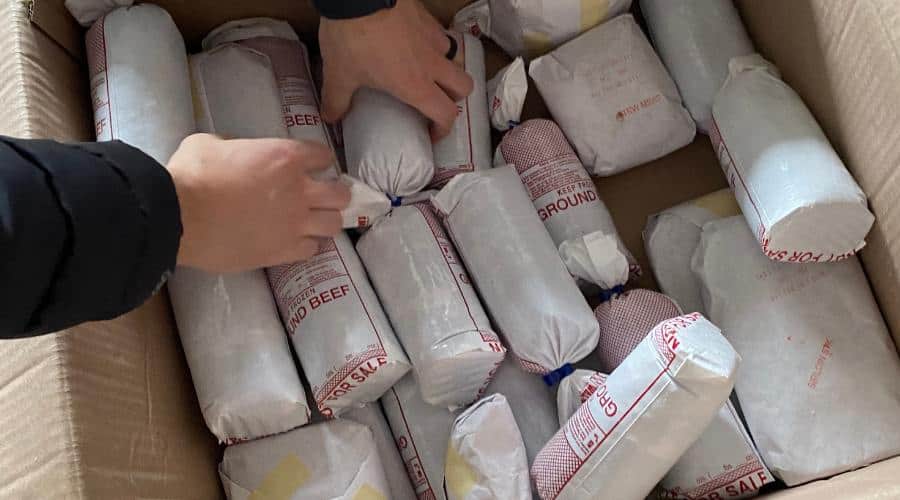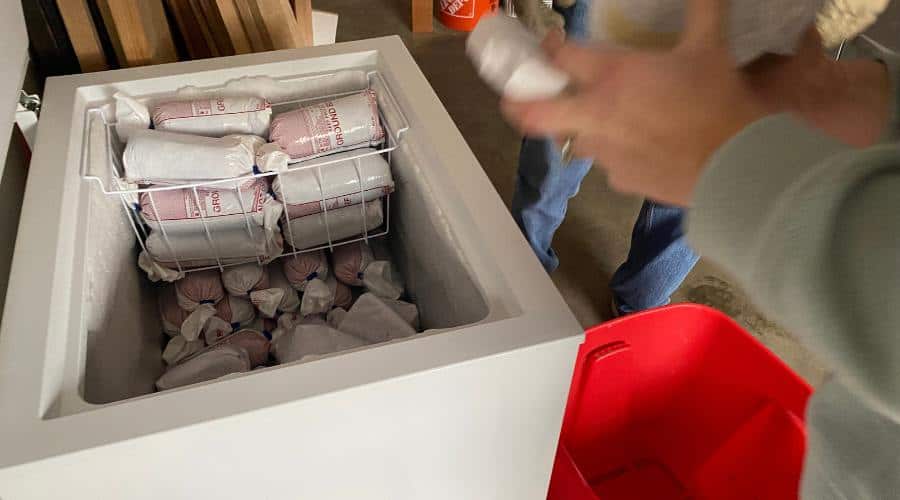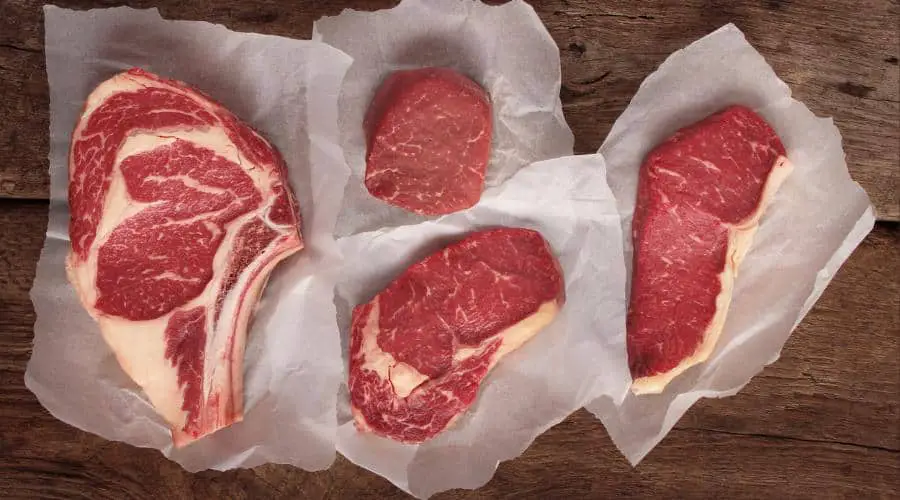From the time I was young, I remember my parents buying half a beef in bulk about every other year. We would buy it in bulk from a family member that would raise beef cows and then pick it up from a butcher, frozen and wrapped. We would then take it home, write the date on the package, and rotate the meat with our last bulk beef purchase, if there was any left, by moving it to the front of the freezer.
Saving money by buying beef in bulk is something my husband and I have decided we want to make a priority for our family and have it as part of our food storage. We have a large freezer and make sure we budget for it each year or two.
Buying in bulk is a great way to build your food storage as well as save money (see the best places to buy food in bulk online). When buying beef in bulk it is not uncommon to receive various cuts of beef (including ground beef, steaks, roasts, etc.) which could come close to the same price as a pound of just 20/80 hamburger. Buying beef in bulk is a great way to save money if you are someone who likes different cuts of beef.
Where to Buy Beef in Bulk
5 different places where you can buy beef in bulk include:
- Directly from a farmer or rancher
- From a local butcher shop
- Through a buying club or co-op
- From a warehouse store
- From an online retailer
Buying food and groceries in bulk has blessed my family by saving us money and providing us with a food supply that can sustain the family during a food shortage or other emergencies. Consider if buying food in bulk is actually cheaper for you and find an Amish-style bulk food store near you.
1. Directly From a Farmer or Rancher
Many small farmers and ranchers sell their beef in bulk directly to consumers. This can be a great option if you want to support local farmers and agriculture and know where your beef is coming from.
To buy beef in bulk, look for local farmers or ranchers who raise beef in your area. You can find farmers in your area by checking local farmers’ markets, online marketplaces, or contacting your state’s agriculture department.
Reach out to the farmer or rancher to learn more about their beef, including the cuts they offer (this may be up to the butcher), the conditions under which the animals are raised, and the price per pound.
Once you have found a farmer or rancher whose beef meets your needs and budget, place your order. Be sure to follow any instructions for payment and delivery. Also, make sure to check if buying your beef and getting it butchered will be two separate costs.
It may be possible that you buy the cow from the farmer and will need to find your own butcher to butcher the cow.
If you’re wondering if it’s cheaper to buy beef directly from a farmer, see our article about if it is cheaper to buy beef in bulk.

2. From a Local Butcher Shop
In some areas, it is common to have multiple butcher shops. These shops often sell bulk amounts of beef in different cuts and amounts. You may need to get on a schedule.
To buy beef from a local butcher shop, look for a butcher shop in your area that sells beef. You can use online directories or ask for recommendations from friends or family or ask in a local Facebook group.
Visit the butcher shop and check out their selection of beef. Ask about the cuts they have available, the quality of the beef, and the conditions under which the animals were raised.
Once you have found a cut of beef that meets your needs and budget, place your order. Some butcher shops may allow you to place an order in advance to ensure that they have the beef you want.
Follow the butcher shop’s instructions for payment and pick up. Some butcher shops may offer delivery, but others may require you to pick up the beef in person.

3. Through a Buying Club or Co-op
Buying clubs and co-ops are organizations that allow members to purchase food in bulk at discounted prices. These groups often work with local farmers and ranchers to source their products.
To buy beef through a club or Co-op, look for a buying club or co-op in your area that sells beef. You can use online directories or ask for recommendations from friends or family or ask a local Facebook group.
Contact the buying club or co-op to find out what cuts of beef they have available, the quality of the beef, and the conditions under which the animals were raised.
Most buying clubs and co-ops require you to be a member in order to purchase their products. You may need to pay a membership fee or meet certain requirements in order to join.
Once you have joined the club or co-op and found a cut of beef that meets your needs and budget, place your order. Some buying clubs and co-ops may allow you to place an order in advance to ensure that they have the beef you want.
Follow the buying club or co-op’s instructions for payment and pick up. Some clubs and co-ops may offer delivery, but others may require you to pick up the beef in person.
There are many buying clubs and co-ops that sell beef. Here are some of the most popular:
- Local Harvest: Local Harvest is a website that connects consumers with local farmers, ranchers, and other food producers. You can use their directory to find buying clubs and co-ops in your area that sell beef.
- Good Eggs: Good Eggs is an online grocery delivery service that works with local farmers and ranchers to source their products. They offer a wide selection of beef from small-scale producers.
- Community Supported Agriculture (CSA): CSAs are organizations that allow members to purchase a share of a farmer’s harvest in advance. Some CSAs offer shares of beef in addition to vegetables and other products.
- Ranch Foods Direct: Ranch Foods Direct is a direct-to-consumer meat company that works with small-scale producers to source their products. They offer a wide selection of beef, including grass-fed and grain-finished options.
- Crowd Cow: Crowd Cow is an online marketplace that allows you to purchase beef directly from small-scale producers. They offer a variety of cuts and options, including grass-fed and grain-finished beef.
4. From a Warehouse Store
To buy beef from a warehouse store, look for a warehouse store in your area that sells beef. Some popular options include Costco, Sam’s Club, and BJ’s Wholesale Club.
Visit the warehouse store and check out their selection of beef. Ask about the cuts they have available, the quality of the beef, and the conditions under which the animals were raised.
Most warehouse stores require you to be a member in order to purchase their products. You may need to pay a membership fee or meet certain requirements in order to join.
Once you have become a member and found a cut of beef that meets your needs and budget, place your order. Some warehouse stores may allow you to place an order in advance to ensure that they have the beef you want.
Follow the warehouse store’s instructions for payment and pick up. Some stores may offer delivery, but others may require you to pick up the beef in person.

5. From an Online Retailer
To buy beef from an online retailer, look for an online retailer that sells beef. You can find a wide variety of options and have the beef delivered directly to your doorstep.
There are many online retailers that specialize in selling beef in bulk. Some popular options include Crowd Cow, Ranch Foods Direct, and Butcher Box.
Visit the online retailer’s website and check out their selection of beef. Ask about the cuts they have available, the quality of the beef, and the conditions under which the animals were raised.
Once you have found a cut of beef that meets your needs and budget, add it to your cart and place your order. Follow the online retailer’s instructions for payment and delivery.
The beef will be delivered to your doorstep. Follow proper food safety guidelines for storing and preparing the beef to ensure that it stays fresh and safe to eat.
When buying beef in bulk, it’s important to consider the quality of the meat and the conditions under which it was raised. Look for beef that is grass-fed and humanely raised, as this will likely be more nutritious and better for the environment. It’s also a good idea to ask the store about their sourcing practices to ensure that you are comfortable with where the beef is coming from.
You should also consider how you will store and use the beef, as buying in bulk will require you to freeze some of the meat in your home freezer.
7 Easy Steps to Buying Beef in Bulk and Saving Money
- Decide what type of beef you want
- Determine your budget
- Shop around
- Consider the quality of the beef
- Make a plan for storing and using the beef
- Place your order
- Store and use the beef
1. Decide on the type of beef you want: Consider the cuts of beef that you prefer and how you will use them. This will help you determine how much beef you need and what type of beef to buy.
The most common cuts are:
- Steak: including ribeye, sirloin, and tenderloin
- Roast: including chuck roast, round roast, and rump roast
- Ground beef
- Brisket
- Short ribs
- Stew meat
- And more
2. Determine your budget: Knowing how much you are willing to spend will help you narrow down your options and find the best deal. Compare your bulk beef price per unit to beef options in the store before you purchase any so that you know if it is a good deal or not.
3. Shop around: Compare prices and options from different sources, such as local farmers and ranchers, buying clubs or co-ops, warehouse stores, and online retailers.
4. Consider the quality of the beef: Look for beef that is grass-fed and humanely raised, as this will likely be more nutritious and better for the environment.
5. Make a plan for storing and using the beef: Buying in bulk may require you to freeze some of the meat, so make sure you have enough freezer space and bags.
6. Place your order: Once you have found the right source and type of beef at a price you are comfortable with, place your order. Be sure to follow any instructions for payment and delivery.
7. Store and use the beef: Follow proper food safety guidelines for storing and preparing the beef to ensure that it stays fresh and safe to eat.
Is it Cheaper to Buy Beef in Bulk?
It can be cheaper to buy beef in bulk, especially if you are able to find a good deal from a farmer or rancher or if you are able to take advantage of discounts at a warehouse store. When buying beef in bulk it can greatly reduce the cost of more expensive cuts of beef such as steaks and roasts. See in more detail if buying beef in bulk is cheaper with a breakdown and cost comparison.
Buying in bulk can also save you money by reducing the overall cost of packaging and transportation. However, it’s important to keep in mind that the price of beef can vary significantly depending on the cut, quality, and location. It’s always a good idea to shop around and compare prices to make sure you are getting the best deal.
If you are considering buying beef in bulk, it’s also important to think about how you will store and use the meat. Buying in bulk may require you to freeze some of the meat, which can add to the overall cost if you need to purchase additional freezer space or bags.
6 Benefits of Buying Beef in Bulk
When it comes to purchasing beef, buying in bulk can have several advantages. Here are six potential benefits to consider:
- Cost savings: One of the biggest advantages of buying beef in bulk is that it can save you money in the long run. When you buy beef in bulk, you typically get a discount on the price per pound. This can add up to significant savings over time, especially if you’re a regular beef consumer. It’s always important to compare prices per pound with regular purchases, you could be surprised how much you save.
- Convenience: Buying beef in bulk also eliminates the need to make multiple trips to the store, which can save you time and money on gas. This can be especially beneficial if you live in a rural area or if your grocery store is far away.
- Quality control: When buying in bulk, you can often purchase beef directly from a farmer or producer, which can give you greater control over the quality of the meat you’re buying. You can also choose the cut you want, check the packaging and expiration date, also check if its grass-fed or grain-fed, among other options.
- Long-term storage: Buying beef in bulk allows you to stock up on your favorite cuts of beef, ensuring that you always have them on hand. This can be especially useful if you’re someone who likes to meal prep, as you can easily plan your meals for the week or even the month.
- Supporting local agriculture: Buying beef in bulk from local farmers or producers can be a great way to support your local agriculture community. When you purchase beef from local sources, you’re investing in the local economy and helping to ensure that small farms and ranches have a sustainable source of income. Additionally, locally sourced beef is often fresher and can be of higher quality than beef that has been transported long distances. When you buy from local farmers, you can also have more information about their farming practices, which is a great way to make sure you’re buying beef that is raised ethically and sustainably.
- Reduced packaging waste: By purchasing beef in bulk, you reduce the amount of packaging waste associated with buying smaller quantities of meat. This is environmentally friendly and a great way to decrease your carbon footprint.
As always, it’s important to weigh the pros and cons of buying beef in bulk before making a decision. Keep in mind that what works for one person may not work for another, so it’s always good to do your own research and calculations. And with that, you can make an informed decision that works best for you and your budget.

3 Disadvantages of Buying Beef in Bulk
While there are many benefits to buying beef in bulk, there are also a couple of disadvantages to consider. In this section, we’ll take a look at three potential downsides to buying beef in bulk.
- The risk of spoilage: One of the biggest concerns with buying beef in bulk is the risk of spoilage. If you purchase too much beef and don’t use it in time, it can go bad before you have a chance to eat it. This can be especially problematic if you’re purchasing a large quantity of beef, as it can be difficult to use it all up before it spoils. To avoid this, make sure you have a plan for using up the beef in a timely manner and consider freezing most of it if you won’t be able to use it all before it goes bad.
- Upfront cost: Another downside to buying beef in bulk is that it requires a significant upfront investment. You may need to pay for a large quantity of beef all at once, which can be difficult for some people, particularly those on a tight budget. Make sure you have enough budget and also compare prices with your local store or supermarket
- Storage space: Buying beef in bulk also requires a significant amount of storage space. You’ll need a place to store the beef before you use it, which can be a challenge for those with limited space in their home. If you don’t have enough storage space, consider buying smaller quantities or sharing the purchase with a friend or family member.
It’s important to weigh these potential disadvantages against the potential savings from buying beef in bulk to determine whether it’s the right choice for you. Keep in mind that buying in bulk may not always be the cheapest option and it depends on the store’s discounts, but also on the quantity you are buying.
3 Ways to Store Bulk Amounts of Beef
There are additional methods, tips, and details that will help you get the longest shelf life out of your beef and you can see how by checking out our 6 ways to properly store beef to maximize its shelf life.
- Freeze it: One of the most common ways to store bulk beef is to freeze it. When bought from a local butcher, beef is usually wrapped and frozen before pickup.

To freeze beef, wrap it tightly in plastic wrap or aluminum foil and place it in a freezer bag. Squeeze out as much air as possible before sealing the bag. You can also use a vacuum sealer to remove all of the air from the bag. Properly wrapped and sealed beef can last for up to 12 months in the freezer.
- Cure it: Another option for storing bulk beef is to cure it using salt, sugar, and other seasonings. Cured beef, such as bacon or jerky, can last for several months if stored in a cool, dry place.
- Can it: You can also preserve bulk beef by canning it. Canning involves heating the beef to a high temperature and sealing it in a canning jar with a tight-fitting lid. Properly canned beef can last for up to a year in a cool, dry place.
When storing bulk beef, it’s important to follow proper food safety guidelines to prevent the risk of foodborne illness. This includes keeping the beef at the proper temperature, using clean utensils and containers, and following recommended storage times.


